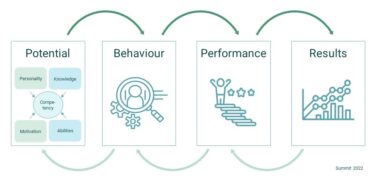Potential, behaviour, performance and results are all closely linked elements in the competency mapping process. By identifying and understanding these interrelated factors, a company can gain greater clarity about which competencies are needed to achieve specific results and success.
By identifying the necessary competencies for a given position, you can evaluate whether employees and managers possess these competencies and have the potential to exhibit the expected behaviour and achieve the level of performance that leads to the anticipated results. Conversely, you can also define desired results and performances and identify the necessary behaviours and competencies that can lead to these results.

Time saving and efficiency
The competency mapping process offers a number of advantages. First of all, it saves time for the company as it structures the conversations and focuses on the most important skills. By knowing which competencies are crucial for the specific role, the interviewer can use their time and energy more efficiently during the interview and, among other things, make sure to ask the same questions to all candidates. It also creates a more positive experience for the candidate, as the focus is on specific skills and behaviours that are relevant to the role. This creates transparency and fairness in the recruitment process.
Competency mapping also provides the opportunity to analyse the company’s culture and identify competencies that support this culture. It is crucial to understand how the chosen competencies harmonise with the company’s values and strategy. Through the process, the company gets an overview of what competencies they have across the organisation and can thereby see if they match the desired behaviour and culture. This allows the company to recruit and develop managers who specifically fit the strategy.
Competency clarification
A typical competency mapping process starts with understanding a company’s specific needs and goals regarding a specific role. The required management skills and behavioural traits are analysed to achieve these objectives. The company culture, strategy, and expected results are also evaluated. Since a specific competency is interpreted differently in different companies, this is an important step to create a solid foundation for the mapping process. An example could be the identified competency “To drive change” which in some companies means being action-oriented and delivering a lot of results whereas in other companies the same competency means being visionary and creating a lot of new ideas.
The next step involves matching the company’s chosen competencies with Hogan’s 62 competencies, to identify the most relevant and correlating competencies. The essential part is to identify correlations between what Hogan measures and the chosen competency. To ensure a strong correlation a mix of scales from the three Hogan Assessments HPI, HDS and MVPI are identified for each competency.
A competency mapping report is then prepared, which shows how the Hogan scales are important and how they correlate to the desired behaviour. It reveals in which area on each Hogan scale the candidate is a match or which scales are of concern in relation to all the leadership capabilities that have been identified for the specific role. The report is evaluated by the company to ensure that the competency mapping aligns with the company’s expectations and culture.
After the candidate has completed their Hogan assessments the company can bring both the assessment and the competency mapping report to have a more enlightening interview that focuses on the desired competencies and the validation of these.
Optimising the recruitment and development process
Competency mapping creates a clear structure and coherence in the recruitment and development process. It helps identify the key competencies essential for a given role and assesses whether candidates match these competencies. By using competency mapping as a central tool, the company can avoid bias and ensure a more objective evaluation of the candidates. It also allows candidates to be compared across specific competencies and create a more fair and comparable assessment.
By mapping competencies, the company can understand the potential to exhibit, the behaviour, performance and results and make more informed decisions about recruitment, development and promotions. It provides the opportunity to identify and develop the right skills in employees and managers who can drive the organisation’s success and achieve strategic goals. At the same time, the company can ensure a better connection between individual performance and organisational results, which is crucial for achieving growth and competitive advantages.
Want to know more about competency mapping and solutions for you, then let’s talk at +45 4585 1515 or info@summitlead.com



